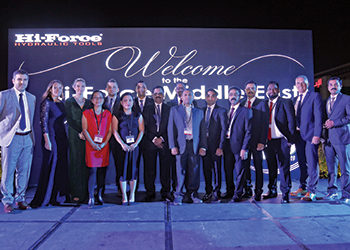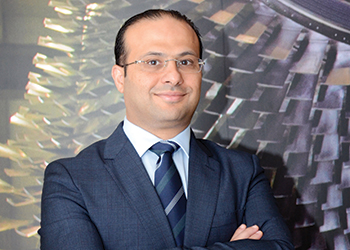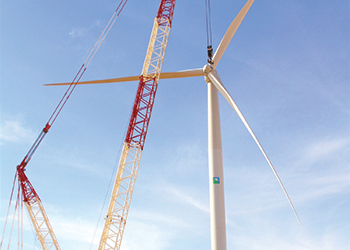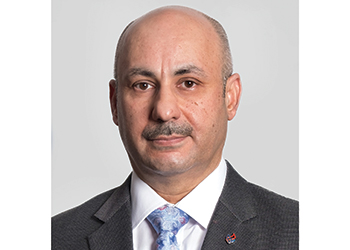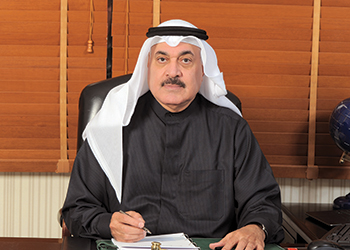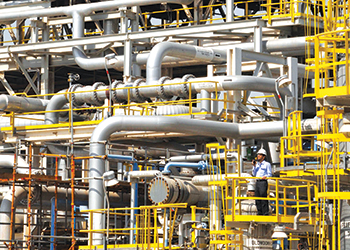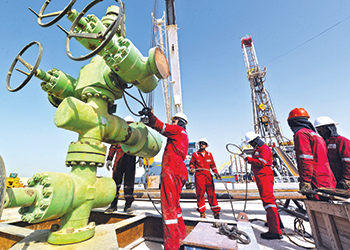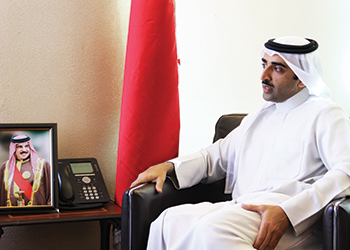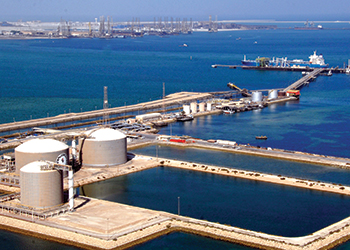
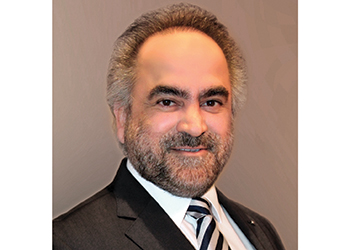 Dr Jawahery ... dynamic approach
Dr Jawahery ... dynamic approach
The company undertook some 36 capital projects worth about $40 million. These capex projects under implementation range from replacement of ammonia and methanol loading arms through to the upgrading and enhancement of field instruments
Bahrain-based the Gulf Petrochemical Industries Company (GPIC) has reported record production and sales last year despite difficult global economic conditions and a decline in oil prices, says GPIC President Dr Abdulrahman Jawahery.
Ammonia and urea production reached 1,617,422 metric tonnes of which urea alone accounted for 704,003 tonnes, he tells OGN in an exclusive interview.
During 2016, GPIC’s exports of ammonia, urea and methanol totalled 1,234,125 tonnes, which is 3 per cent higher than the budgeted figures for the year and 11 per cent higher than the previous year’s actual exports.
"In terms of breakdown, we exported 78,218 tonnes of ammonia, while methanol exports totalled 443,729 tonnes and granular urea exports in bulk totalled 712,179 tonnes," he says.
"GPIC’s entire production is intended for export due to the limited demand in the local market for our products. We are one of the very few international fertiliser and petrochemical industries that meet the stringent production quality requirements for key markets such as Australia and the United States," he says.
Excerpts from the interview:
What were the highlights of GPIC’s performance in 2016?
An important landmark in 2016 for GPIC was our achieving more than 24,901,727 million work hours without a lost time accident, equivalent to 5,365 workdays. This is a remarkable feat and truly showcases GPIC’s utmost commitment to the health and well-being of every single employee and every single contractor who works in our complex.
GPIC also won the RoSPA Award in the field of Occupational Safety, health and environment protection and renewed its commitment to social responsibility by winning the Arab Award for Social Responsibility among Arab companies. This is further testament to how GPIC is implementing all of its Sustainability and Stewardship goals in line with international United Nations (UN) initiatives.
Another highlight for us during 2016 was when GPIC reinforced its dynamic approach to human resources by again receiving international recognition with an award for Excellence in the field of Human Resources Management in the private sector category.
In terms of the development of work systems, we added two important certificates in terms of our quality in laboratory work and technical inspection of equipment. This increased our number of quality assurance certificates to 14, bringing GPIC right to the forefront of institutions receiving certificates to ensure quality performance.
GPIC has been able to achieve all this and more during the year, including record targets for our production and in achieving all of our quality export targets to the international market.
What was the total production target for 2016? What was the capacity utilisation at all the three plants? What have been the production trends for GPIC in terms of all three products?
GPIC’s Ammonia plant achieved the maximum daily average production during the first eight months of 2016. This equates to a daily average rate of 1,287 tonnes over operating days. Overall, the picture is a similar one with the complex achieving a maximum daily average production of sealable products in the same period at a daily rate of 3,348.4 tonnes. The breakdown for all three products over 2016 was, 1,284 tonnes/day of ammonia, 1,905 tonnes/day of urea and 1,226 tonnes/day of methanol.
As you know, GPIC is at the forefront of its drive for state of the art technology and its approach to supreme maintenance for its operations. As a part of enhancing the efficiency and reliability of the complex, two important projects were carried out successfully. These were the refurbishment of one of the Utilities boilers and, the installation of an additional potable water tank
The cumulative total of 13.1 million tonnes of ammonia and 12.9 million tonnes of methanol production has been achieved by end of December 2016 since the full operations of the plants was initiated in 1985. Since 1998, 11.6 million tonnes of Urea production has been achieved by end of December 2016.
What were the export statistics for 2016? How does it compare with 2015? What is the projection for 2017?
During 2016, GPIC’s exports of ammonia, urea and methanol totalled 1,234,125 tonnes, which is 3 per cent higher than the budgeted figures for the year and 11 per cent higher than the previous year’s actual exports. In terms of breakdown, we exported 78,218 tonnes of ammonia, while methanol exports totalled 443,729 tonnes and granular urea exports in bulk totalled 712,179 tonnes.
 |
GPIC’s board members and the management |
GPIC’s entire production is intended for export due to the limited demand in the local market for our products. We are one of the very few international fertiliser and petrochemical industries that meet the stringent production quality requirements for key markets such as Australia and the United States.
The company’s total exports for all three products was delivered on 64 ships and in addition, 951 tonnes of bagged urea was sold in the local Bahraini market.
Year 2015 was of course our turnaround year and as such, our production figures for that year would not make for reasonable comparison. Suffice to say that this year’s record production brought the total GPIC ammonia and methanol exports to world markets since the company’s inception in 1985, to nearly 6.6 million tonnes of ammonia and 12.8 million tonnes of methanol.
GPIC’s urea exports, since the takeoff of our urea operations in 1998 now total around 11.5 million tonnes, while the cumulative total of all products exported from GPIC now exceeds 30.9 million tonnes. Despite all the challenges encountered during the year, GPIC still ended the year on a positive note, both in terms of volumes of products exported to world markets and, in achieving attractive netbacks on all its three products – ammonia, methanol and urea.
What is GPIC achieving in terms of sustainability and the environment?
GPIC is not only a market leader in business but a well-known champion in sustainability.
Through the years we have scaled up the sustainability practices and initiatives and currently lead in a number of ways. The current focus of our sustainability initiatives is leadership, collaboration and innovation.
Utilising the globally established GRI framework we have conducted the most extensive stakeholder engagement to ascertain the materiality of the sustainability issues we advocate. Not only have we published our third GRI Compliant Sustainability Report in June 2016, but we have also attained the highest level of reporting as a member of the UN Global Compact.
Our report also serves as GPIC’s UN Global Compact Communication on Progress (COP) and its signature issue platforms such as the Women’s Empowerment Principles and the Food and Agriculture Business Principles.
 |
GPIC ... focus on the environment |
As an outcome of our deep commitment to Climate Change action in relation to COP21, GPIC has provided its employees with training on the IPCC Carbon Inventory software and has used this platform to issue their first Greenhouse Gas (GHG) Inventory Report.
Like other responsible businesses, GPIC too has directed its focus onto the Sustainable Development Goals and has proactively started to review, link and align its business priorities with the global priorities as articulated in the 17 Sustainable Development Goals. As a first step, we have shown our alignment to the global goals by linking our long term sustainability goals to the SDGs. We have also started engaging the youth of our company and the Kingdom of Bahrain through awareness campaigns on SDGs.
GPIC’s leadership commitment and support for sustainable agriculture, food security and poverty eradication and its engagement with international organisations such as UNGC, UNEP, FAO gained significance and further momentum throughout 2016 when GPIC’s President became the International Fertiliser Industry Association (IFA) President. GPIC’s President is also an active member of UNEP’s HLG for GEO 6 and provides guidance and policy position on regional assessments.
How much worth of capex projects were undertaken by GPIC in 2016? What were the main projects undertaken?
2016 was a challenging year for all industries, however GPIC maintained its commitments in terms of maintenance, modifications and new specification technologies.
Major approved capex projects during the upcoming turnaround 2018 are well under way and will no doubt, facilitate in enhancing the safety and reliability of our process plants. This year our engineering department completed around 200 modifications arising from rigorous process hazards assessments conducted by the division.
During 2016, GPIC undertook some 36 capital projects worth about $40 million. These capex projects under implementation range from replacement of ammonia and methanol loading arms through to the upgrading and enhancement of field instruments and control valves.
What were the tasks undertaken by the maintenance department in 2016 to improve reliability? How many orders were undertaken for 1) preventive maintenance 2) corrective maintenance 3) modifications?
In 2016, GPIC’s Maintenance Department continued its consistent efforts to enhance safety and reliability throughout the complex, placing special emphasis on the process plants. Accordingly, the Objectives and Key Performance Indicators for the department were set and monitored closely on a quarterly basis, resulting in our objectives being achieved.
Our maintenance activities (both routine and major) ranged from water-proofing a bulk storage roof. A gas turbine major overhaul, through to structure and pipe rack painting in our methanol plant. In total, GPIC undertook 90 modifications and 12 capital projects, with almost 5,000 preventive maintenance activities, 131 inspections and, some 2,500 corrective maintenance activities.
 |
GPIC’s Maintenance Department continued its consistent efforts |
GPIC has sustained its reliability through the manner in which it continuously develops its people. All maintenance employees were involved in training courses, including safety, health and environment and e-Learning courses. Each of our employees attended an average of 57 training hours each with 82 of our staff being awarded certified course accreditation.
How much CO2 is being treated daily after the commissioning of the carbon capture system at GPIC?
In partnership with Mitsubishi Heavy Industries (MHI), GPIC hosted a technical conference on carbon dioxide extraction during the latter part of 2015. GPIC was the first company in the region to successfully construct its Carbon Dioxide Recovery Unit and employ such technology. The conference gave us the opportunity to share our extensive expertise and knowledge with the industry sector in this regard.
Our organisation holds the protection and sustainability of the environment in the highest regard and we will continue to endeavour to share our capability with everyone in this sector and seek out the latest environment-friendly technologies in the petrochemical manufacturing process.
Our CDR, which has been in full operation since 2009, has so far extracted over 700,000 tonnes of carbon dioxide, which has been used to enhance the production of urea and methanol. This translates to an average of 200,000 Nm3/day CO2 being captured by the CDR recovery unit.
How did GPIC enhance and strengthen its Health, Safety and Environmental (HSE) management systems in 2016? What were the achievements?
2016 was another extremely successful year for GPIC in terms of Safety, Security, and Health and Environmental (SSHE) excellence. Throughout the year, GPIC continued to enhance and strengthen its Safety, Security, Health and Environmental (SSHE) management systems including training, capacity building and testing of its emergency response and preparedness.
These continual improvement efforts culminated in achieving a record 24.9 million working hours for its workforce and contractors without any lost time accident.
As mentioned, this dedication to SSHE stewardship afforded GPIC the opportunity to be awarded with the RoSPA Chemical Sector Award from the Royal Society for the Prevention of Accidents (RoSPA). This award was presented to GPIC for its outstanding application of SHE standards and for undertaking a leading role in this area.
Being a Responsible Care certified Company, GPIC’s drive for excellence has become a way of life. One of the latest initiatives is our TeenDrive module in partnership with the National Safety Council-USA and Bahrain’s Ministry of Interior with this initiative being launched country wide, it will target and assist the improvement and safety of young drivers.
In 2016, GPIC continued to provide Safety training for both Operations and Non-Operations personnel alike, including fire and safety training, SHE training certification with IMIST (International Minimum Industry Safety Training) for contractors and Safety Media e-learning. Just over 75 per cent of all employees have successfully received their in house basic firefighting training.
GPIC has also, in cooperation with UNEP and the Ministry of Education continued with the Green Wave initiative that was launched in 2015. Through this programme we sponsor and facilitate the planting of local trees at public schools in order to promote biodiversity awareness and encourage environmental stewardship. Furthermore, GPIC has recycled 96 tonnes of plastic, paper, metal cans and card board which has resulted in our carbon footprint reduction by 164 tonnes CO2.
Our engineers presented a number of environmental lectures in both public and private schools. The total number of students benefiting from this program has crossed 27,500 since 2001 and, for the tenth consecutive academic year, GPIC has sponsored the Ministry of Education/GPIC Environmental Research Program for the GPIC Environment Award for secondary school students.



















































































